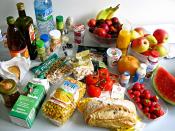Thesis: What you should know about irradiated food.
Purpose: to educate
Audience: Consumers
Irradiation of food is a controversial topic at the present. Any person who eats is affected and those who are responsible for nourishing their families need to know everything they can about food irradiation so that they can make an informed decision for themselves and a safe one for those they feed. There currently is an effort to educate consumers about irradiated food and its presence. According to Nuclear News magazine 68% of Americans are aware of beef irradiation.
What is Food Irradiation?
Food irradiation is a food safety technology that, most importantly, can eliminate disease-causing germs from foods and destroy microorganisms that could otherwise lead to illness or death. It can also lengthen a food products shelf life and control mold. It can be used in fruits and vegetables to delay sprouting and ripening, and control insects and parasites as an alternative to fumigation and use of other chemicals( ).
(reword this)The process of irradiation makes its way into food, killing microorganisms without significantly increasing the temperature of the food. Since the process does not increase the temperature, it has been referred to as "cold" pasteurization. This process is similar to the process of pasteurizing milk (CCR).
The History of Food Irradiation
Food irradiation has a long history of scientific research and testing, with more than 40 years preceding approval of the process for any foods in the United States( ). To date, no other food technology has had as long a history of scientific research and testing before gaining approval (ADA). The first U.S. and British patents were issued for use of ionizing radiation to kill bacteria in foods in 1905. During World War II, the U.S. Army began a series of experiments with fruits,


